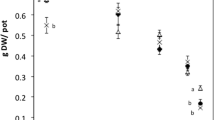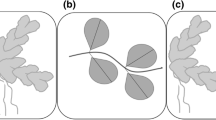Abstract
Elodea canadensis Michx. and Myriophyllum spicatum L. are widespread nuisance aquatic plant species. Their ecology is regarded as similar. Both species have been previously classified in terms of established-phase survival strategy as ‘competitive disturbance-tolerant’ species. Experimental data are presented to show that although this broad categorisation of strategy is probably correct for the two species, it is possible to demonstrate significant differences in terms of response to disturbance and competition. Less difference was discernible in their comparative response to stress. The drawbacks of applying broad descriptive terminology when dealing with two species of similar strategy are addressed. The results help explain reports of variable success in attempting to manage these two species using disturbance-based weed control measures, and suggest that Elodea is even less susceptible to such measures than Myriophyllum.
Similar content being viewed by others
References
Abernethy, V. J., 1994. The functional ecology of euhydrophyte communities of European riverine wetland ecosystems. Ph. D. Thesis, University of Glasgow. 265 pp.
Anderson, L. W. J., 1990. Aquatic weed problems and management in the western United States and Canada. In A. H. Pieterse & K. J. Murphy (eds), Aquatic Weeds. Oxford University Press, Oxford: 371–391.
Barko, S. W. & R. M. Smart, 1981. Comparative influences of light and temperature on the growth and metabolism of selected submersed freshwater macrophytes. Ecol. Monogr. 51: 219–235.
Bornette, G., C. Henry, M.-H. Barrat & C. Amoros, 1994. Theoretical habitat templets, species traits and species richness: aquatic macrophytes in the Upper Rh6ne River and its floodplain. Freshwat. Biol. 31: 487–505.
Chambers, P. A. & J. Kalff, 1985. The influence of sediment composition and irradiance on the growth and morphology of Myriophyllum spicatum L. Aquat. Bot. 22: 253–263.
Grime, J. P., 1979. Plant strategies and vegetation processes. Wiley, Chichester. 222 pp.
Grime, J. P., J. G. Hodgson & R. Hunt, 1988. Comparative plant ecology. A functional approach to British species. Unwin & Hyman, London. 742 pp.
Hendry, G. A. F. & J. P. Grime, 1993. Methods in comparative plant ecology. Chapman & Hall, London. 252 pp.
Hills, J. M., K. J. Murphy, I. D. Pulford & T. H. Flowers, 1994. A method for classifying European riverine wetland ecosystems using functional plant groups. Funct. Ecol. 8: 242–252.
Madsen, J. D., J. W. Sutherland, J. A. Bloomfield, L. W. Eichler & C. W. Boylen, 1991. The decline of native vegetation under dense Eurasian watermilfoil canopies. J. Aquat. Plant Mgmt 29: 94–99.
Martin, M. P. L. D. & R. W. Snaydon, 1982. Analysis of competition experiments. J. Appl. Ecol. 19: 263–272.
Murphy, K. J., T. O. Robson, M. Arsenovic & W. van der Zweerde, 1990a. Aquatic weed problems and management in Europe. In A. H. Pieterse & K. J. Murphy (eds), Aquatic Weeds. Oxford University Press: Oxford: 295–317.
Murphy, K. J., B. Rørslett & I. Springuel, 1990b. Strategy analysis of submerged lake macrophyte communities: an international example. Aquat. Bot. 36: 303–323.
Nichols, S. A. & B. H. Shaw, 1986. Ecological life histories of three aquatic nuisance plants, Myriophyllum spicatum, Potamogeton crispus and Elodea canadensis. Hydrobiologia 131: 3–21.
Pautou, G. & M.-F. Arens, 1994. Theoretical habitat templets, species traits and species richness: floodplain vegetation in the Upper Rhône valley. Freshwat. Biol. 31: 507–522.
Sabbatini, M. R. & K. J. Murphy, 1996. Submerged plant survival strategy in relation to management and environmental pressures in drainage channel habitats. Hydrobiologia 340 (Dev. Hydrobiol. 120): 191–195.
Sheldon, R. B. & C. W. Boylen, 1979. Maximum depth inhabited by aquatic vascular plants. Am. Midl. Nat. 97: 248–254.
Simpson, D. A., 1984. A short history of the introduction and spread of Elodea Michx. in the British Isles. Watsonia 15: 1–9.
Smith, C. S. & J. W. Barko, 1990. Ecology of Eurasian watermilfoil. J. Aquat. Plant Mgmt 28: 55–64.
Steward, K. K., 1990. Aquatic weed problems and management in the eastern United States. In A. H. Pieterse & K. J. Murphy (eds), Aquatic Weeds. Oxford University Press: Oxford: 391–405.
Author information
Authors and Affiliations
Rights and permissions
About this article
Cite this article
Abernethy, V.J., Sabbatini, M.R. & Murphy, K.J. Response of Elodea canadensis Michx, and Myriophyllum spicatum L. to shade, cutting and competition in experimental culture. Hydrobiologia 340, 219–224 (1996). https://doi.org/10.1007/BF00012758
Issue Date:
DOI: https://doi.org/10.1007/BF00012758




